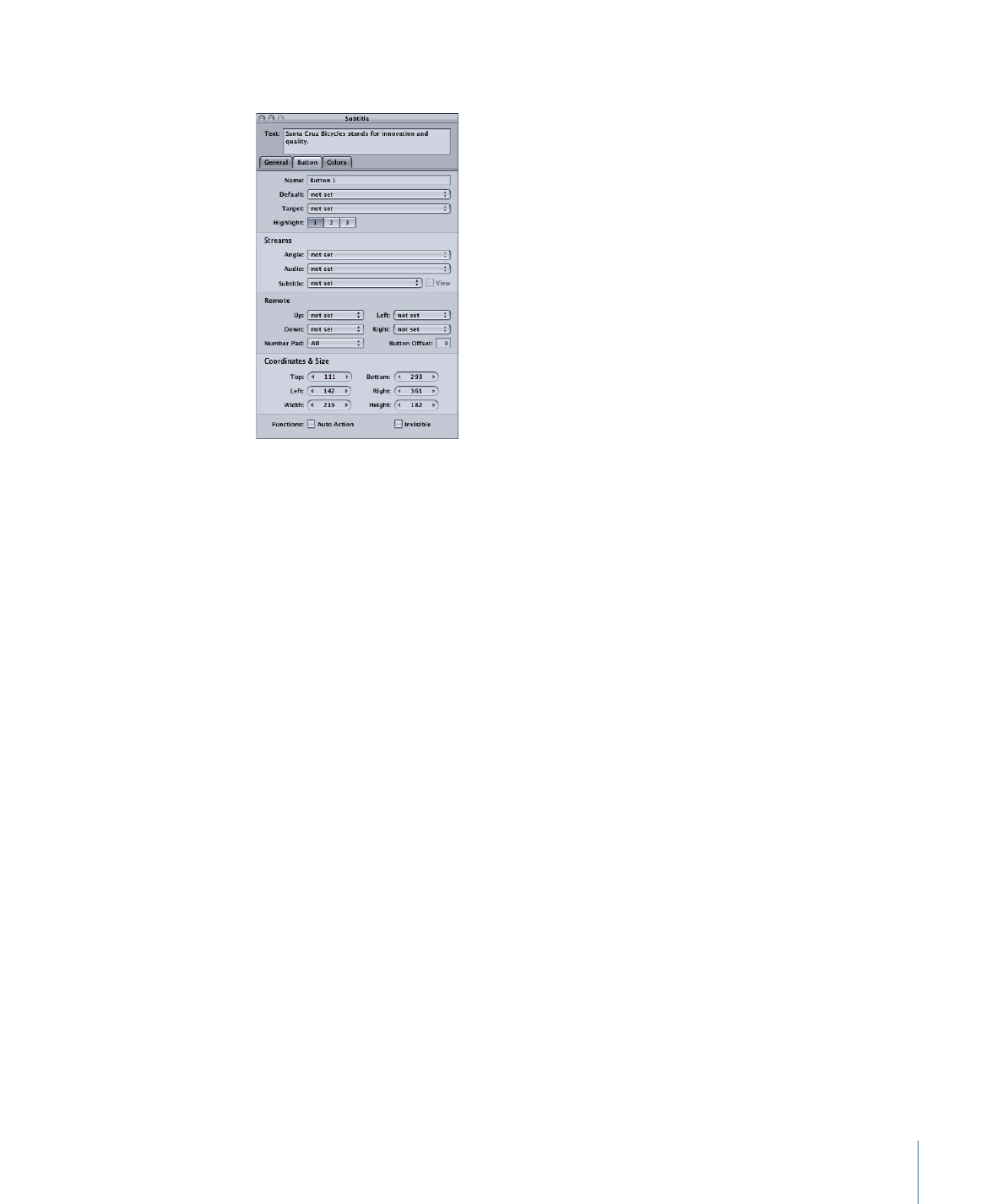
Button Tab in the Subtitle Inspector
The Button tab in the Subtitle Inspector is empty unless the subtitle is configured to
provide buttons over video. See
Creating Buttons over Video
for more information.
450
Chapter 19
Creating Subtitles

You use the Button tab to configure the buttons to add to the subtitle.
• Name: By default, buttons are named “Button _,” where “_” is the button number in
that menu. To reduce confusion when viewing a list of the menu’s buttons, it is helpful
to rename the buttons based on their functions.
• Default: Choose the button to be selected when the subtitle appears during playback
of the title. This setting can be overridden by any element that jumps to this subtitle’s
marker, based on its jump setting.
• Target: You can use this pop-up menu to define a button’s action when activated. (You
can also use the Connections tab or Control-click the button.) Often you must set the
connection later because what you want to jump to has not been added to the project
yet. The pop-up menu contains all possible elements you can jump to.
• Highlight: Select the color mapping set (1, 2, or 3) to use for this button.
• Angle/Audio/Subtitle Streams: Use these three pop-up menus to have a button select
specific angle, audio, and subtitle streams to play back. For the subtitle stream, you
can also choose whether subtitles should appear. These settings are only active if the
target is set to “not set.” You can set the target to run a script if you want a button to
jump to a specific stream in a different track.
• Remote: This area lets you set the actions that take place when the viewer uses the
arrow buttons on the DVD player’s remote control to navigate through the title. Because
this is the typical way the title will be viewed, it is important to spend some time
configuring the navigation in a logical, predictable way. See
Configuring Button
Navigation
for information.
451
Chapter 19
Creating Subtitles

• Number Pad: Defines which buttons are directly accessible by a DVD player’s numeric
keypad. Choose All, None, or a button number from the pop-up menu. When you
choose a button number, that button and all buttons less than that number are
accessible via the numeric keypad—buttons greater than this value are blocked from
direct access.
Important:
This feature is based on the order in which the buttons are created. In most
cases, this order is the same as the default button names shown in the Viewer. This
button order can be changed if you delete a button and later add a new button—the
new button’s default name is not a reliable indicator of the order in which the buttons
were created.
• Button Offset: You can use this to offset button numbers so they make sense to a viewer
who wants to select a button by entering its number. For example, you may have a set
of scene selection menus with numbered scenes. One of the menus may have scenes
23 to 34, with the button for scene 23 being the first button on the menu. If you enter
an offset value of 22 for this menu, when the viewer enters 23 on the remote control,
22 is subtracted from it, with the result being 1—the button’s actual number.
• Coordinates & Size: This area lets you set the location of each edge of the button’s active
area, plus the area’s height and width. The upper-left corner of the menu is at pixel 0,
line 0. You can enter values for each edge, allowing you to precisely position and size
the button’s active area. (You can also drag the area and each of its edges with the
pointer.)
• Auto Action: If you select Auto Action for a button, the button activates automatically
as soon as it is navigated to, without the viewer needing to press Enter. This is useful
in menus, such as scene selection menus, in which you use Next and Previous buttons;
you can assume that if viewers navigate to the Next or Previous button, they want to
activate it.
With overlay-based buttons, if you select this option, only the activated color mapping
appears when the button is navigated to, skipping the selected color mapping.
Important:
When viewed with most software-based DVD players, such as the Apple
DVD Player, auto action buttons must be clicked if a mouse is used to select buttons.
If you use the computer’s arrow keys, however, auto action buttons activate
automatically as with set-top DVD players.
• Invisible: Applies to overlay-based buttons. Allows you to have a button that does not
display highlights in the normal, selected, or activated state. This is useful when you
want to have a menu with text and no visible buttons. The text could tell the viewer
to press the Enter button to go to the next menu or start playback (or whatever the
button is set to jump to).
452
Chapter 19
Creating Subtitles